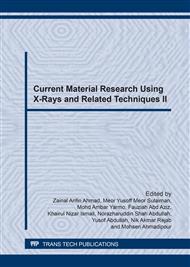[1]
M.M. Gudarzi, F. Sharif, Enhancement of dispersion and bonding of graphene-polymer through wet transfer of functionalized graphene oxide, Express Polymer Letters 6(12) (2012) 1017-1031.
DOI: 10.3144/expresspolymlett.2012.107
Google Scholar
[2]
S. Chatterjee, J.W. Wang, W.S. Kuo, N.H. Tai, C. Salzmann, W.L. Li, R. Hollertz, F. A. Nuesch, B.T.T. Chu, Mechanical reinforcement and thermal conductivity in expanded graphene nanoplatelets reinforced epoxy composites, Chemical Physics Letters 531 (2012).
DOI: 10.1016/j.cplett.2012.02.006
Google Scholar
[3]
A. M. Clayton, Epoxy resins: Chemistry and technology, Marcel Dekker, New York, (1988).
Google Scholar
[4]
X. Wang, J. Jin, M. Song, An investigation of the mechanism of graphene toughening epoxy, Journal Carbon 65 (2013) 324-333.
DOI: 10.1016/j.carbon.2013.08.032
Google Scholar
[5]
W.D. Bascom, R.L. Cottington, R. L. Jones, P. Peyser, The fracture of epoxy- and elastomer-modified epoxy polymers in bulk and as adhesives, Journal of Applied Polymer Science 19(9) (1975) 2545-2562.
DOI: 10.1002/app.1975.070190917
Google Scholar
[6]
M.N.R. Nair, P.K. Biju, G.V. Thomas, M. R. Gopinathan Nair, Blends of PVC and epoxidized liquid natural rubber: Studies on impact modification, Journal of Applied Polymer Science 111(1) (2009) 48-56.
DOI: 10.1002/app.28884
Google Scholar
[7]
R.A. Pearson, A. F. Yee, Influence of particles size and particle size distribution on toughening mechanisms in rubber-modified epoxies, Journal of Materials Science 26(14) (1991) 3828-3844.
DOI: 10.1007/bf01184979
Google Scholar
[8]
D.R. Paul, C.B. Bucknall, Polymer blends: Toughening of epoxies, John Wiley & Sons, Milton, (2000).
Google Scholar
[9]
V.S. Mathew, C. Sinturel, S. C. George, S. Thomas, Epoxy resin/liquid natural rubber system: secondary phase separation and its impact on mechanical properties, Journal of Material Science 45 (2010) 1769-1781.
DOI: 10.1007/s10853-009-4154-8
Google Scholar
[10]
Y.S. Lee, H.A. Sahrim, R. Rozaidi, S.Y. Noum, C.H. Yew, M. Tarawneh, Effect of liquid natural rubber (LNR) on the mechanical properties of LNR toughened epoxy composite, Sains Malaysiana 40(7) (2011) 679-683.
Google Scholar
[11]
P.N. Khanam, D. Ponnamma, M.A. Al-Madeed, Graphene-based polymer nanocomposites in electronic: Electrical properties of graphene polymer nanocomposites, Springer International Publishing, Switzerland, (2015).
DOI: 10.1007/978-3-319-13875-6_2
Google Scholar
[12]
L.X. He, S.C. Tjong, Low percolation threshold of graphene/polymer composites prepared by solvothermal reduction of graphene oxide in the polymer solution, Nanoscale Research Letters 8(1) (2013) 132.
DOI: 10.1186/1556-276x-8-132
Google Scholar
[13]
T. Lan, P.D. Kaviratna, T.J. Pinnavaia, Mechanism of clay tactoid exfoliation in epoxy-clay nanocomposites, Chemistry Materials 7(11) (1995) 2144-2150.
DOI: 10.1021/cm00059a023
Google Scholar
[14]
M.A. Ahmed, U.F. Kandil, N.O. Shaker, A.I. Hashem, The overall effect of reactive rubber nanoparticles and nanoclay on the mechanical properties of epoxy resins, Journal of Radiation Research and Applied Science 8 (2015) 549-561.
DOI: 10.1016/j.jrras.2015.06.010
Google Scholar


